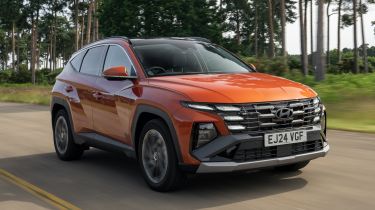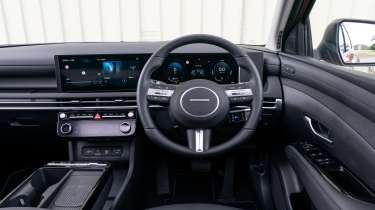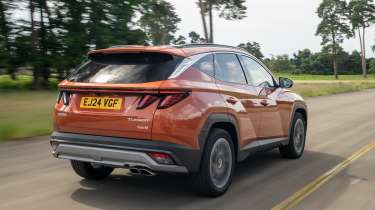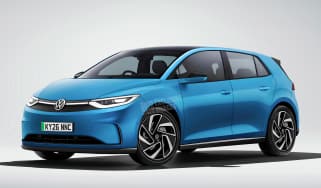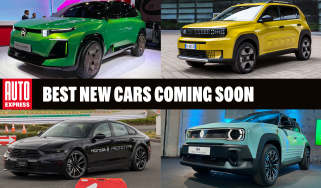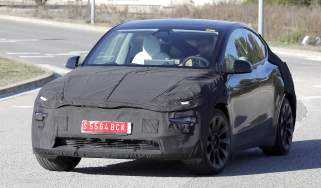Hyundai Tucson Hybrid 2024 review: class-leading SUV gets subtle improvements
There’s been a nip and a tuck for the class-leading compact SUV

Verdict
Subtle exterior updates and a revised dashboard fail to upset the overall appeal that makes the Hyundai Tucson one of our class favourites. It’s still a practical, spacious and user-friendly package that delivers a comfortable drive and a fuss-free ownership proposition. There are still a lot of beeps from the safety systems, but Hyundai has made it easier to turn them off if you want to, and while the hybrid model has less power than before, it still delivers a great balance between performance and economy.
Mid-life facelifts are a great opportunity for car makers to update models that have fallen short of expectation, but what do you do when the vehicle in question is already judged to be a class leader? That was the quandary faced by the Hyundai Tucson, a car that we’ve singled out in the closely-fought compact family SUV market as one of the best options on offer.
But after three years on sale, the fourth-generation Tucson has been given a makeover, and it’s obvious that Hyundai has stuck with the mantra of ‘if it ain’t broke, don’t fix it’. On the outside there’s a new grille design, although it’s just a subtle smoothing over of the outgoing car’s geometric look, and a redesigned, chunkier front bumper and a new skid plate.
More reviews
Car group tests
- Hyundai Tucson vs Ford Kuga vs Vauxhall Grandland: which is the ultimate hybrid family SUV?
- Volkswagen Tiguan vs Hyundai Tucson 2024 twin test: family SUVs fight it out
- Renault Austral vs Hyundai Tucson: 2023 twin test review
- Kia Sportage vs Hyundai Tucson: 2022 twin test review
- Kia Sportage PHEV vs Hyundai Tucson PHEV: 2022 plug-in hybrid SUV twin test review
In-depth reviews
Road tests
Used car tests
At the rear, the cutout featuring the Hyundai badge at the base of the windscreen is now set behind the glass for a smoother look (the rear wiper is still tucked under the tailgate spoiler above), and the bumper features a squarer lower section, too. There are new alloy wheel designs as well, but that’s about it for the exterior revisions.
It’s inside where the more significant changes have been made. Gone is the T-shaped centre console of the outgoing car, replaced by a pair of landscape screens mounted side-by-side, similar in layout to the Ioniq 5 EV. Hyundai claims that this new layout, including a new horizontal bar that spans to the passenger side for the lowered central air vents, is designed to “create a sense of openness”. We never thought the outgoing car felt particularly cramped, though, while a minor quibble is that the new layout puts the furthest corner of the central touchscreen a long reach away from the driver, especially if their driving position is set back.
The two-zone climate control features rotary selectors for cabin temperature, while the rest of the functions are located in a black touch panel between them. Press a feature, and a light pulses from either side of the icon to show it’s been used, although we still think a physical button would be a better option in this instance. The shortcuts above the climate panel help you to navigate the main screen and are similar to the ones found in other recent Hyundai's, while the software within the touchscreen is as user-friendly as you need.
In fact, Hyundai has improved some of its functionality. The Tucson’s driver-assistance systems are comprehensive, but this means it can have a tendency to beep and bong incessantly. In the old car, if they proved too much, you’d have to access a menu within a menu on the main touchscreen. But now there are shortcuts on the multifunction steering wheel that achieve the same result; if you want to deactivate the speed limit warning (it beeps when it detects a new limit, and also beeps if it senses that you are exceeding it), simply press the mute button on the volume control for a few seconds, and silence reigns.
The Tucson features Hyundai’s ccNC (connected car Navigation Cockpit) display, and this includes over-the-air updates, natural language voice recognition and real-time navigation information. There’s a higher-resolution display for the reversing camera, plus wireless Apple CarPlay and Android Auto are both supported.
The new centre console creates more space lower down on the dashboard, while the old car’s push-button drive selector has been ditched in favour of a column-mounted control. Again, this is similar to the selector found in the Ioniq 5 and Kona, and its repositioning means there’s now a large, open tray beneath the climate controls, and the centre armrest now has a wireless phone charging tray next to the twin cup holders. There are some shortcut buttons on the leading edge of the armrest, too, for the parking sensors and reversing camera system, hill descent control, auto hold and drive modes.
As well as a cabin revamp, the Tucson’s engine range has been given some efficiency tweaks. The entry-level 148bhp 1.6-litre turbo petrol now has 158bhp, while the twin-clutch auto model continues with 48-volt mild-hybrid technology. Another update is that this model is now available with four-wheel drive, too.
The mid-spec Tucson Hybrid now has 212bhp, down from 227bhp for the old model, while official fuel economy is quoted at 47.9mpg. Four-wheel drive is also available for the first time on this model, as well. At the top of the range, the Tucson PHEV has 250bhp – down from 261bhp before – and is also offered with two or four-wheel drive.
As ever, the Tucson features plenty of kit even in entry-level guise. The Advance spec includes LED lights, 17-inch alloys, keyless entry, front and rear parking sensors, two-zone climate control and the 12.3-inch central display with wireless Carplay and Android Auto, wireless phone charging and four USB-C sockets.
Move to Premium trim, and there are 18-inch wheels, an eight-speaker Krell sound system, adaptive cruise control for the auto-equipped models, a powered tailgate, heated steering wheel and heated front seats with part-leather trim.
The N-Line has 19-inch wheels and body-coloured wheelarches, sportier styling and suede-effect interior trim, while the N-Line S adds ventilated front seats, heated rear seats, panoramic glass and matrix LED headlights.
At the top of the range, the Ultimate driven here combines all of the kit of Premium and N Line S plus adds memory seats, while the full suite of safety features include surround view cameras, blind-spot monitors and a parking distance warning.
On the road, the Tucson delivers comfort over sporty handling, and the new car offers a driving experience that matches that of the outgoing car. You don’t really miss the extra power of the old hybrid model – a 0-62mph time of 8.2 seconds is still fast enough for most needs – because this is a car that’s designed to get passengers from A to B safely and without drama.
Light steering means it’s a doddle to manoeuvre at low speeds, while the assorted camera systems give you a clear view of your surroundings – helped here by the assorted warning buzzers and beeps just to make sure you’re aware of what’s going on around you.
At higher speeds, the suspension absorbs bumps well and body roll is kept in check, while the engine fades away to the background and wind noise is low, ensuring the Tucson is a comfortable motorway cruiser. For a car that delivers family transport, the revised Tucson maintains the standards set by the outgoing model, while the quality of life updates haven’t tainted its reputation in the slightest.
| Model | Hyundai Tucson 1.6T Hybrid Ultimate |
| Price: | £40,640 |
| Engine: | 1.6-litre 4cyl hybrid |
| Power/torque: | 212bhp/264Nm |
| Transmission: | Six-speed automatic, front-wheel drive |
| 0-62mph: | 8.2 seconds |
| Top speed: | 116mph |
| Economy: | 47.9mpg |
| CO2: | 133g/km |
| Size (L/W/H): | 4,510/1,865/1,653mm |
| On sale: | Now |

